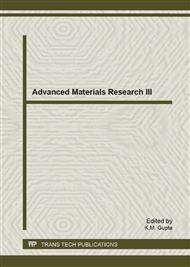[1]
N. Yamazoe: Sensor. Actuator. B Vol. 5 (1991), p.7
Google Scholar
[2]
A. Gurlo, M. Ivanovshaya, N. Barsan, M. Schweizer-Berberich, U. Weimar, W. Gopal and A. Dieguez: Sensor. Actuator. B Vol. 44 (1997), p.327
Google Scholar
[3]
A. Cirera, A. Vila, A. Dieguez, A. Cabot, A. Cornet and J.R. Morante: Sensor. Actuator. B Vol. 64 (2000), p.65
Google Scholar
[4]
R. Ramamoorthy, M.K. Kennedy, H. Nienhaus, A. Lorke, F.E. Kruis and H. Fissan: Sensor. Actuator. B Vol. 88 (2003), p.281
DOI: 10.1016/s0925-4005(02)00370-2
Google Scholar
[5]
M.-M. Bagheri-Mohagheghi and M. Shokooh-Saremi: J. Phys. D: Appl. Phys. Vol. 37 (2004), p.1248
Google Scholar
[6]
J. Morales, V.C. Perez, S. Santos and L.J. Tirado: J. Electrochem. Soc. Vol. 143 (1996), p.2847
Google Scholar
[7]
M.V. Artemyev, V. Sperling and U. Woggon: J. Appl. Phys. 81 (1997), p.6975
Google Scholar
[8]
M.C. Schlamp, X. Peng and A.P. Alivisatos: J. Appl. Phys. 82 (1997), p.5837
Google Scholar
[9]
D. Aurbach, A. Nimberger, B. Markovsky, E. Levi, E. Sominski and A. Gedanken: Chem. Mater. Vol. 14 (2002), p.4155
DOI: 10.1021/cm021137m
Google Scholar
[10]
Y.-N. Nuli, S.-L. Zhao and Q.-Z. Qin: J. Power Sources, Vol. 114 (2003), p.113
Google Scholar
[11]
M. Miyauchi, A. Nakajima, T. Watanable and K. Hashimoto: Chem. Mater. Vol. 14 (2002), p.2812
Google Scholar
[12]
L.B. Fraigi, D.G. Lamas and N.E. Walsoe de Reea: Mater. Lett. Vol. 47 (2001), p.262
Google Scholar
[13]
K.C. Song and J.H. Kim: Powder Technol. Vol. 107 (2000), p.268
Google Scholar
[14]
H. Zhaohui, G. Neng, L. Fanqing, Z. Wanqun, Z. Huaquiao and Q. Yitai: Mater. Lett. Vol. 48 (2001), p.99
Google Scholar
[15]
N.S. Baick, G. Sakai, N. Miura and N. Yamozoe: Sensor. Actuator. B Vol. 3 (2000), p.4
Google Scholar
[16]
L.H. Xian, Y.-J. Zhu and S.-W. Wang: Mater. Chem. Phys. Vol. 88 (2004), p.421
Google Scholar
[17]
T. Krishnakumar, N. Pinna, K.P. Kumari, K. Perumal and R. Jayaprakash: Mater. Lett. Vol. 62 (2008), p.3437
Google Scholar
[18]
D. Briand, M Labeau, J.F. Curie and G. Delabouglise: Sensor. Actuator. B Vol. 48 (1988), p.395
Google Scholar
[19]
S.-C. Lee, J.-H Lee, T.-S Oh and Y.-H. Kim: Sol. Energy Mater. Sol. Cells Vol. 75 (2003) p.481
Google Scholar
[20]
S.-S. Chee and J.-H. Lee: Electron. Mater. Lett. Vol. 8 (2012), p.53
Google Scholar
[21]
S.-S. Chee and J.-H. Lee: Accepted in Electron. Mater. Lett.
Google Scholar


